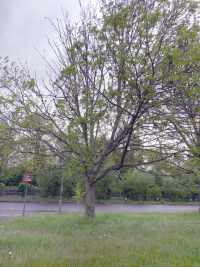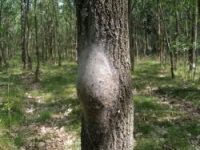Surrey County Council is responsible for dealing with highway trees which have the potential to cause harm to pedestrians, other non-motorised users or vehicles. We are currently experiencing a number of pests and diseases that are increasingly affecting the trees in Surrey.
Page contents
- Ash Dieback (Hymenoscyphus fraxineus) and felling trees adjacent to the highway
- Our approach to monitoring and dealing with Ash Die Back
- Replanting trees
- Oak Processionary Moth
- Our approach to dealing with Oak Processionary Moth

Ash Dieback (Hymenoscyphus fraxineus) and felling trees adjacent to the highway
Ash Dieback is a disease caused by a fungus called Hymenoscyphus fraxineus. The disease causes leaf loss and crown dieback in affected trees, and it may lead to trees losing large limbs or the death of the tree. More information can be found on the Ash Dieback webpage.
Our approach to monitoring and dealing with Ash Dieback
We survey annually all large groups of ash trees along the highway which have been identified as suffering from Ash Dieback.
The surveys verify if the trees have deteriorated further over the last 12 months or stayed the same. The tree groups are then prioritised in alignment with how we maintain our trees.
We aim to fell large groups of trees outside the bird nesting season, although occasionally we will fell trees within that period if the safety of the highway is at risk. Works carried out during the bird nesting season require our contractors to undertake a good physical check of the trees and surrounding area to ensure that nesting birds are not disturbed.
Due to the way that trees are affected by Ash Dieback, traditional methods of felling the trees are not always possible. This may mean that large machinery is used to fell the trees. Timber from the felled trees is sometimes left, in rural areas, to provide a natural habitat for the existing wildlife.
Additionally, dead hedging can be created to provide shelter for small mammals, insects and birds. The material will eventually rot away in ways which are good for ecosystems but this takes quite a few years as the branches are largely off the ground.
Replanting trees
Where we have had to remove large areas of trees, we will monitor the site and consider for replanting in future years. Any replanting will be subject to funds being available, the site being assessed as suitable, and not having statutory undertaker plant under ground which could be affected by any new trees,
Additional information on other highway trees planting is available on the planting trees on the highway webpage.

Oak Processionary Moth (Thaumetopoea processionea)
The oak processionary moth is a pest that has been found in Surrey since 2017-18. It lives on oak trees and poses a risk to human and animal health. More information can be found on the advice about oak processionary moth webpage.
Our approach to dealing with Oak Processionary Moth (OPM)
Surrey County Council Highways prioritise nest removal following a risk-assessment approach to each site. We look at each nest according to its location on the tree and the location of the tree. The highest priority is where there is a strong likelihood of interaction with someone using the highway or close by. This means we will remove nests which are within arms reach of someone walking along the pavement or there is a high interaction by a number of people, such as at a bus stop or outside a school.
We will record all locations of reported OPM nests on highway trees and monitor those sites.
It is not practical for us to remove all nests, as often there are private trees adjacent to the highway trees, which if not treated at the same time as the highway trees, will just reinfect the highway tree.

